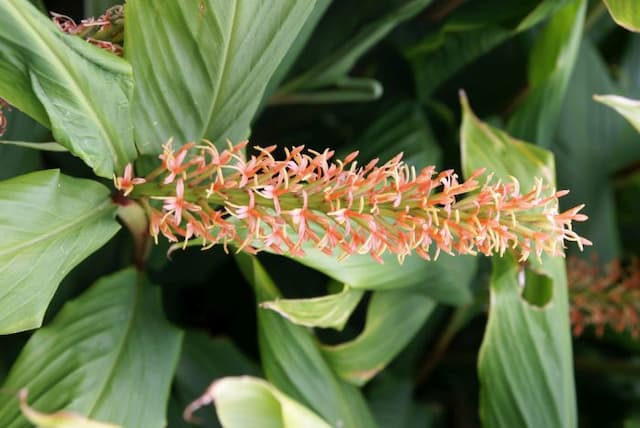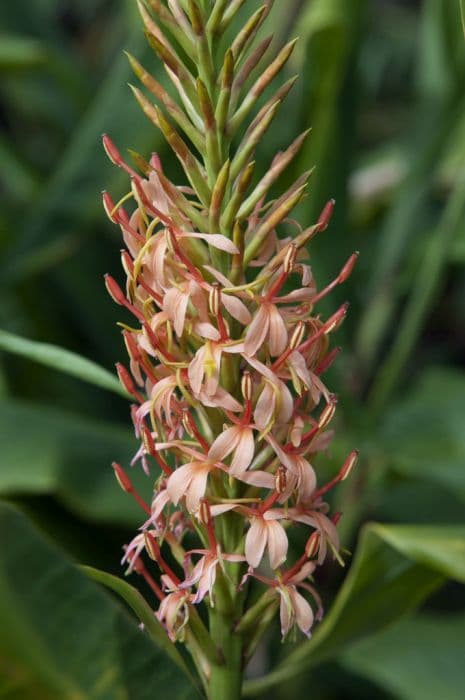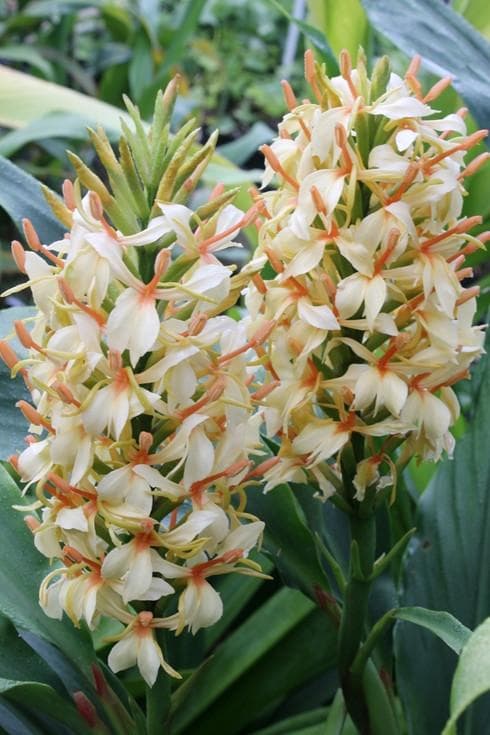Himalayan ginger Roscoea cautleyoides 'Himalaya'

ABOUT
The plant known as Himalayan ginger is a perennial with a striking presence. This plant showcases lush green foliage, with each leaf elongating from the base and often having a lance-shaped appearance that tapers to a point. During its blooming period, it produces large and attractive flowers. The blossoms are usually a vibrant yellow, quite showy, and shaped similar to orchid flowers, making them stand out against the greenery. These flowers are often marked with subtle purple or reddish-brown spots or streaks, adding to their exotic look. The plant has a somewhat clumping form, with the leaves and flowers emerging directly from the ground. The overall impression is one of a delicate yet robust plant that adds a touch of the exotic to any garden setting.
About this plant
 Names
NamesFamily
Zingiberaceae
Synonyms
Himalayan Ginger, Cautley's Roscoea
Common names
Roscoea cautleyoides 'Himalaya'.
 Toxicity
ToxicityTo humans
The Roscoea, commonly known as Himalaya ginger, is not widely known for its toxicity to humans. There are no well-documented cases or reports that suggest the Himalaya ginger is poisonous to humans when touched or ingested. However, as with any plant, individual allergies or sensitivities can exist, and it's generally advisable to avoid eating ornamental plants unless they are known to be edible. If a person were to ingest Himalaya ginger and experience symptoms such as nausea, vomiting, diarrhea, or any other adverse effects, they should seek medical attention.
To pets
The Himalaya ginger is not typically listed as a toxic plant to pets such as dogs and cats. There is limited information on the toxicity of this specific variety of Roscoea to animals. In the absence of definitive data or reports of poisoning, it is reasonable to assume that this plant is not highly toxic to pets. However, pet owners should always be cautious and prevent pets from consuming plants not meant for their diet. Should a pet ingest Himalaya ginger and exhibit symptoms like vomiting, diarrhea, lethargy, or other unusual behavior, it is recommended to consult with a veterinarian.
 Characteristics
CharacteristicsLife cycle
Perennials
Foliage type
Deciduous
Color of leaves
Green
Flower color
Purple
Height
1-2 feet (0.30-0.60 meters)
Spread
0.5-1 feet (0.15-0.30 meters)
Plant type
Herb
Hardiness zones
6
Native area
Himalayas
Benefits
 General Benefits
General Benefits- Ornamental Value: Roscoea cautleyoides 'Himalaya', commonly known as ginger lily, adds aesthetic appeal to gardens with its striking purple flowers and lush foliage.
- Drought Resistance: Once established, ginger lily can tolerate periods of drought, making it suitable for low-water gardens.
- Cold Hardy: With good cold tolerance, it can survive in cooler climates where other tropical plants may fail.
- Attracts Pollinators: The vibrant flowers are enticing to pollinators like bees, which can help to pollinate surrounding plants.
- Low Maintenance: Requiring minimal care once established, ginger lily is ideal for gardeners who prefer less intensive plant upkeep.
- Shade Tolerance: It can thrive in partial shade, offering a blooming option for darker areas of the garden.
- Long Bloom Season: Ginger lily has a long flowering period, providing color and interest in the garden for an extended time.
 Medical Properties
Medical PropertiesThis plant is not used for medical purposes.
 Air-purifying Qualities
Air-purifying QualitiesThis plant is not specifically known for air purifying qualities.
 Other Uses
Other Uses- Ornamental display: The Roscoea cautleyoides 'Himalaya', commonly known as Himalayan ginger, is often used for its aesthetic appeal in ornamental gardens, providing a unique and exotic look.
- Education and research: Botanists and horticulture students may study Himalayan ginger to gain a better understanding of the Roscoea genus and its cultivation requirements in various climates.
- Photography: The striking appearance of Himalayan ginger makes it a popular subject for garden photographers and plant enthusiasts looking to capture its vibrant color and interesting form.
- Theme gardens: This plant can be incorporated into Asian-themed gardens, highlighting its origins and contributing to an authentic representation of Himalayan flora.
- Culinary experimentation: Although not commonly used in cooking, the ginger-like root of the Roscoea species may inspire culinary enthusiasts to experiment with it as a flavoring agent in food dishes.
- Container gardening: Himalayan ginger is suitable for container gardening, offering an option for those with limited space to grow attractive perennials.
- Wildlife attraction: The flowers of Himalayan ginger can attract pollinators like bees and butterflies, aiding in the conservation and support of local ecosystems.
- Artistic inspiration: Artists may draw inspiration from the unique form and color of the Himalayan ginger for various types of artwork, including botanical illustrations and modern abstract pieces.
- Erosion control: The fibrous root system of the Roscoea species can be used to help stabilize soil and control erosion in sloped garden areas.
- Cultural festivals: In regions where it is native or celebrated, Himalayan ginger may play a role in cultural festivals, symbolizing the flora of the Himalayas and featuring in botanical displays.
Interesting Facts
 Feng Shui
Feng ShuiThe Roscoea is not used in Feng Shui practice.
 Zodiac Sign Compitability
Zodiac Sign CompitabilityThe Roscoea is not used in astrology practice.
 Plant Symbolism
Plant Symbolism- Resilience: The plant's ability to thrive in high altitude and rugged terrains of the Himalayas represents its capacity to adapt and persist through tough conditions.
- Rarity: As a lesser-known species, Roscoea cautleyoides 'Himalaya' symbolizes uniqueness and the beauty found in rare and uncommon traits.
- Beauty: The delicate and attractive flowers of the Roscoea cautleyoides 'Himalaya' represent aesthetic beauty and the appreciation of simple elegance found in nature.
 Water
WaterHimalayan Ginger prefers consistent moisture, especially during the growing season. Water the plant thoroughly when the top inch of the soil feels dry to the touch. In general, this might be about once a week, but frequency can depend on the climate and the plant's environment. Ensure the plant receives about 1 gallon of water each time, allowing the soil to become evenly moist without leaving the plant in standing water. During the winter months, reduce watering significantly as the plant enters dormancy.
 Light
LightHimalayan Ginger thrives in partial shade with filtered sunlight. It should be placed in a spot that receives bright but indirect light to mimic its natural woodland habitat. Avoid exposing it to direct afternoon sun, which can scorch the leaves. Dappled morning light or bright shade under taller plants is ideal to maintain the vibrant color and health of the foliage.
 Temperature
TemperatureHimalayan Ginger prefers temperatures between 60°F and 75°F, which simulate the plant's native conditions. It can tolerate a minimum temperature down to around 50°F, but will not survive freezing conditions as it is not frost hardy. Keep it away from cold drafts and ensure the temperature remains consistent to prevent stress on the plant.
 Pruning
PruningPruning Himalayan Ginger is typically not required, but it may be done to remove any dead or damaged foliage and to maintain shape. The best time to prune is in the spring before new growth begins. Removing the old foliage after winter will encourage fresh growth and help keep the plant looking tidy.
 Cleaning
CleaningAs needed
 Soil
SoilThe Himalayan Ginger prefers well-drained soils rich in organic matter, with a slightly acidic to neutral pH of 6.0 to 7.0. A good soil mix can be made by combining loamy garden soil, peat, and sand or perlite to ensure good drainage and aeration.
 Repotting
RepottingHimalayan Ginger should be repotted every 2 to 3 years or when it becomes pot-bound. Use a fresh, nutrient-rich soil mix during repotting to ensure continued growth and health.
 Humidity & Misting
Humidity & MistingThis Himalayan Ginger thrives in moderate to high humidity levels, ideally between 60% and 80%. To maintain adequate humidity, it can benefit from regular misting or placement on a pebble tray.
 Suitable locations
Suitable locationsIndoor
Place in bright, indirect light and keep soil moist for indoor cultivation.
Outdoor
Grow in partial shade, protect from harsh sun, and keep soil consistently moist.
Hardiness zone
6-9 USDA
 Life cycle
Life cycleThe common name for Roscoea cautleyoides 'Himalaya' is Cautleya Spicata. The life cycle starts with seed germination, which requires a period of cold stratification to break dormancy, typically followed by warmth to stimulate growth. Once germinated, seedlings emerge and develop into juvenile plants, forming tuberous roots that allow them to survive unfavorable conditions. The plant enters a mature vegetative stage where it produces long, lance-shaped leaves and begins to store energy in the tuberous roots. During the flowering stage, typically in late spring or summer, Cautleya Spicata produces yellow or pale purple flowers atop leafy bracts, attracting pollinators. After pollination, the flowers develop into seed capsules, and once the seeds mature, the plant enters senescence, with the above-ground foliage dying back, while the tuberous roots overwinter and store energy for the next cycle.
 Propogation
PropogationPropogation time
Spring-summer
Roscoea cautleyoides 'Himalaya', commonly known as Himalayan ginger, is often propagated by division, ideally done in the spring as new growth begins. This method involves carefully separating the rhizomes with a sharp knife ensuring that each division has at least one growth shoot. Divisions should then be replanted at a depth of about 2 to 3 inches (5 to 7.5 centimeters), allowing for the shoots to emerge above the soil surface. The soil should be well-draining and kept moist to encourage rooting and growth. It is important to handle the rhizomes gently to prevent damage and to plant them in a location that receives indirect light and protection from harsh afternoon sun.








